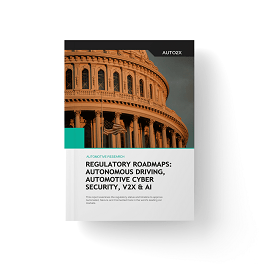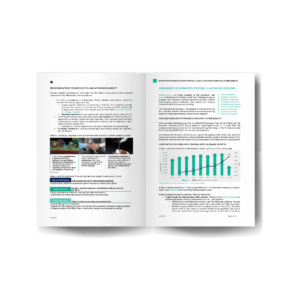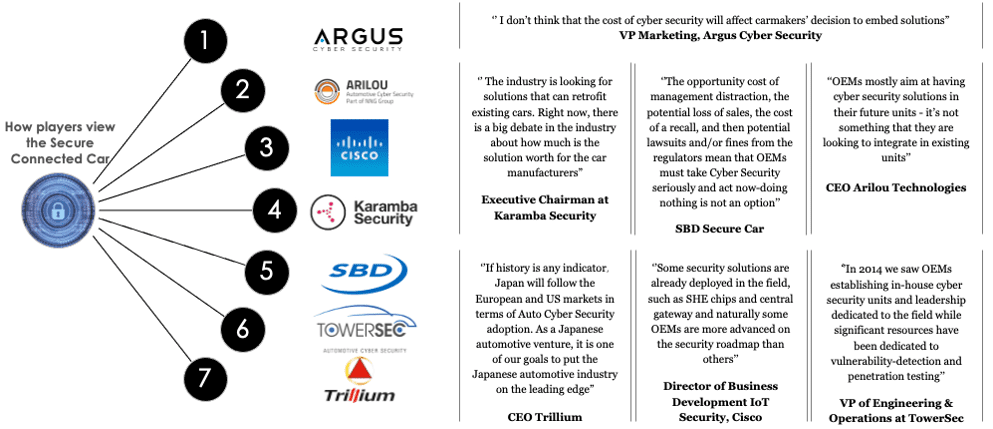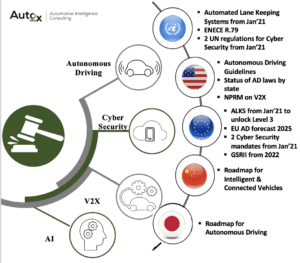Description
Regulatory Roadmaps unveil the transition to autonomous, secure and Connected Car. Read this report to learn about
- The status of the regulatory landscape for the transition from Supervised to Conditionally & Fully-Unsupervised-Driving (SAE Level 3-5).
- The mandatory features of Active Safety, regulations for V2X, and ethical AI.
- Roadmaps and timelines of regulatory mandates and policies in Europe, the USA, China, Japan, the UK and other geographies
- The impact of regulation on market competition and technology adoption
The lack of a harmonized regulatory framework for Level 4-Automated Driving restricts deployment
The lack of harmonization of Autonomous Driving regulation across major car markets remains the key roadblock to the deployment of L3-4.
Carmakers and developers of autonomous driving technology face compliance regulatory requirements that are different across major car markets. For example, for countries such as Japan, China, and the EU members that are signatories of the UNECE regulation, there is no framework for type approval of Level 4.
- Germany, was one of the first countries globally to allow testing of L4 but this applies to robotaxis and autonomous shuttles, not private car ownership.
- On the other hand, the U.S follows self-certification with relevant FMVSS & voluntary guidelines for L4 testing and deployment but there is no federal regulation in place.
- In Apr’22, Japan revised its traffic rules for Level 4 autonomy with enforcement from May 2023.
SAE Lv.4-Full automation describes the scenario where drivers can completely hand over vehicle control and monitoring to the Automated Driving System for specific driving scenarios under the Operational Design Domain of the systems, e.g. Lv.4-Parking Valet parking or L4.-Driving Cruising Chauffeur.
Until today, the only vehicles allowed to operate in Lv.4 Autonomous Driving are robotaxis from Waymo and others. In private car ownership, the highest level of autonomous driving available in the market is Level 3-Conditional Automation.
Regulatory amendment in UNECE finally allowed Level 3-Autonomy in 2021 but global deployment is still fragmented
After almost 3 years in the making, the amendment of UNECE Reg. No.79-Steering Equipment will allow Level 3 in countries adopting the new rules called “Automated Lane Keeping System”.
The ALKS regulation is set to apply to 60 countries including the UK, Japan, and EU member states from January 2021, to enable the safe introduction of ‘Level 3’ automation features in certain traffic environments.
UN regulations manage pre-sale Type Approval, i.e. the Regulation sets out clear performance-based requirements that must be met by car manufacturers before ALKS-equipped vehicles can be sold within countries mandating the Regulation.
“UNECE’s Automated Lane Keeping System regulation is applicable for LEVEL 3, for low-speed (60 km/h) highway-only”
We see Europe and Japan benefiting from the changes in regulation due to the combination of technological capabilities in Level 3 from their domestic carmakers and the favorable political framework to remove roadblocks and establish their respective markets as key innovation hubs.
What are the key challenges in the amendment of regulatory requirements for higher levels of Autonomous Driving?
- As automotive and technology players race to develop and deploy higher vehicle autonomy to unlock enhanced safety in passenger cars and commercial vehicles, new revenues (pricing models of Lv.4, AMoD) and USPs, the slow amendment progress of regulation and the lack of harmonization create barriers for their commercialisation strategies
- Regulation needs to transition from driver-centric to Automated Driving Systems (ADS) to allow today’s Supervised driving (SAE Level 0-2) to shift to Conditionally (SAE Lv3) & Completely-Unsupervised driving; (Lv.4-5). But lack of regulatory standardization across major car markets will create regional hubs (aka “islands”, such as cities where technology is allowed) and require design variation from OEMs
- The vehicle automation mix is changing with the proliferation of Lv2 driving features. In 2020, Euro NCAP released the ratings of 10 Lv.2 / Highway Assist systems marking Audi’s Q8, BMW 3, and GLE “Very Good”.
- With the introduction of Lv.3 allowing Conditionally-Unsupervised driving and vehicles with different levels of autonomy co-existing on the road, clear safety requirements are needed in the form of standardized, international AD regulation which could mitigate scepticism of higher vehicle autonomy.
The transition from driver-centric regulation to Automated Driving Systems will allow the shift from Supervised driving to Conditionally (Lv3) & Completely-Unsupervised driving
Admissibility of automated driving functions depends on the driving and monitoring tasks, i.e. driver engagement, which can be derived by (or inferred by) the level of vehicle automation (SAE J3016 or BASt).
2016-17 saw a shift in the focus of regulation from approving pilots and testing of technologies falling under SAE Level 3/4 to discussion for amendments or event action to enable deployment of Level 3 on public roads. The most evident example was the amendment of the German Road Traffic Act which allows Level 3 from Sep’17, once these systems are type-approved by UNECE regulations.
Meanwhile, the amendment of Regulation No.79 has progressed in Europe to approve Level 3 features under ALKS.
Finally, the world’s largest car market in terms of sales, China, released April 2019, national regulations on-road tests for Autonomous Vehicles as a part of a broader drive to excel in the development of the technology and gain an advantage in the commercialization of autonomous driving technology. This comes after China halted Autonomous Vehicle trials on public roads until relevant standards for Intelligent Connected Vehicles (ICVs) come to force.
We expect regulatory action to accelerate in the remainder of 2020 as key car markets boost their efforts to lead the global Autonomous Vehicle scene -but also guarantee safe and secure deployment.
In this report, we define Autonomous Driving regulation as the regulatory and legal developments regarding the transition from a ‘’driver-centric’’ regulation, which includes
- the “assistive” or “Supervised” ADAS / SAE Level 0-2,
- to “Conditionally” (SAE Level 3)
- & “Completely-Unsupervised” driving (Level 4-5) with or without driver controls, which are in the epicenter of regulatory developments because they will allow (limited to specific use cases or full) hands-off the steering wheel, eyes-off and eventually brain-off.
- In addition to approval and homologations, this framework also includes the transfer of liability from the driver to the ADS as well as issues around Automotive Cyber Security and V2V-V2I.
Levels of Automation based on SAE International’s new standard J3016
| SAE level | Definitions of levels | Driving
features* |
Parking features* | Braking/accel. & steering | Monitoring the road | Ultimate back-up | System capabilities |
| 0 | No automation | BSM, FCW, LDW, TSR, NV | Park Distance Control | Human
driver |
Human
driver |
Human driver | N/A |
| 1 | Driver Assistance | ACC, LKA,
AEB |
Park
Assist |
Human driver / system | Human
driver |
Human driver | Some
modes |
| 2 | Partial-automation | Traffic Jam
Assist, Cruise A. |
Self-parking, Remote Park | **System | Human
driver |
Human driver | Some |
| 3 | Conditional-automation | Traffic Jam Pilot, Highway Pilot | Auto Learning Parking Pilot | System | System | Human driver | Some |
| 4 | High | Confined Highway | Valet parking | System | System | System | Some |
| 5 | Full | Autonomous Journey (incl. D+P) | System | System | System | All modes | |
| Source: SAE International, OEMs, Auto2x / *Examples of features / **System=Automated Driving System (ADS) |
Active Safety Regulations will push ADAS penetration & passenger monitoring
Upcoming regulatory & market requirements push for the expansion of monitoring from drivers to occupants & drive holistic cabin sensing
By mid-2022, all motor vehicles (incl. trucks, buses, vans and sport utility vehicles) in the EU will have to be equipped with Driver Monitoring Systems to mitigate drowsiness and distraction. The regulations will apply 30 months after entry into force with a longer application date provided for a limited number of features in order to allow OEMs to adapt their production to the new requirements.
Automotive Cyber Security becomes mandatory
Over the next decade, as transportation progresses from Connected and Partially-Automated to Highly and Fully-automated, Smart and Shared Mobility, the addition of new sensors and ECUs, new architecture, more Connected devices and V2X will significantly enlarge the vehicle ‘’attack surface”. Identifying, mitigating and responding to cyber threats will not only be paramount for physical road and vehicle safety but also a prerequisite for the transition towards self-driving cars.
ALKS will also need to comply with cyber-security and software update requirements set out in two other new U.N. regulations. In more detail, two new regulations on automotive cybersecurity and software updates to establish clear performance and audit requirements for OEMs are coming into effect in Jan’21.
The 1st is the “UN Regulation on Cybersecurity and Cyber Security Management Systems” and the 2nd the “UN Regulation on Software Updates & Software Updates Management Systems”.
Table of Contents
- Executive Summary
- Regulatory roadmaps to Level 3 and Level 4-Automated Driving in major markets
- ALKS Regulation in UNECE
- USA’s voluntary guidelines
- China ICV
- Japan
- Automotive Cyber Security Regulation
- Data and privacy
- V2X
- AI regulation








